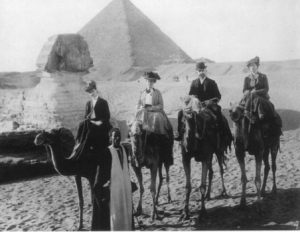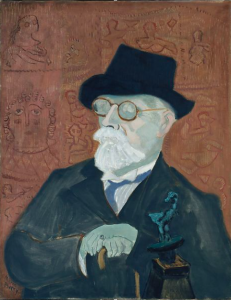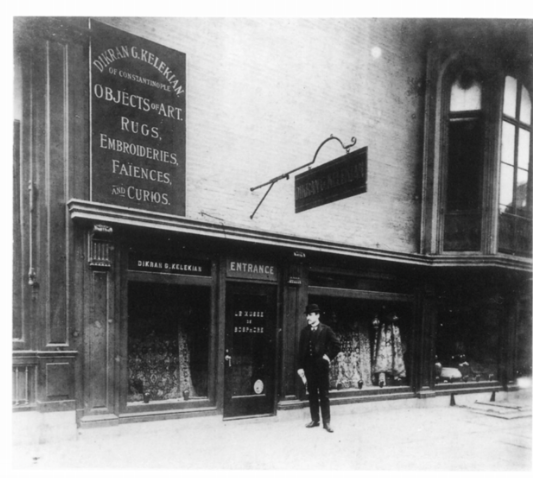Active Dates: c. 1893–1951
Gallerist: Dikran Khan Kelekian
Location:
18931Marilyn Jenkins-Medina, “Collecting the ‘Orient’ at the Met: Early Tastemakers in America,” Ars Orientalis 30 (2000): 73., 18992Advertisement in The Art Collector 9, no. 8 (February 15, 1899), 126.: 303 Fifth Avenue
19033American Art Directory 4 (1903), 188., 1905-19064American Art Directory 5 (1905/6), 575.: 252 Fifth Avenue
1909-19105American Art Directory 7 (1909/10), 308.: 275 Fifth Avenue
19146American Art Directory 11 (1914), 516., 19167American Art Directory 13 (1916), 459., 19188American Art Directory, 15 (1918), 670.: 709 Fifth Avenue
19319“Calendar of Current Art Exhibitions in New York,” Parnassus 3, no. 2 (February 1931) 50., 193710“Exhibitions in New York,” Parnassus 9, no. 5 (October 1937), 40. – April 1939: 598 Madison Avenue
opened May 193911Advertisement announcing the opening of new galleries at 20 East 57th Street in Parnassus 11, no. 5 (May 1939), 2.– 194512New York Supreme Court, Appellate Division-First Department, “In the Matter of Proving the Last Will and Testament of Henry Altmayer,” New York Court of Appeals, Records and Briefs, New York, 1945, 181.: 20 E. 57th Street
194813Arts Magazine 23 (1948), 26.: 32 E. 69th Street
Dikran Kelekian also had galleries located in Paris (10, rue Rossini, and later at 2, Place Vendôme) and Cairo (38 Kasr-el-nil or Opposite the American mission.14Per an advertisement for the gallery in American Art News 20, no. 29 (April 29, 1922): 10. This map of the American mission seems to suggest this is the same location as the Kasr-el-nil address which I found on google maps (it is spelled Kasr al Nile now). “American Mission in Egypt map,” Presbyterian Historical Society, Pearl Digital Collections, https://digital.history.pcusa.org/islandora/object/islandora%3A1799, accessed April 22, 2020. )
Specialty: Islamic art, Ancient Near Eastern art and artifacts. From the 1910s, Kelekian also presented modern French painting. [Areas of particular expertise: Coptic textiles, Persian ceramics]
Gallery History
Dikran Kelekian was an important dealer of Islamic, Coptic, and ancient Near Eastern art, and modern French paintings from the 1910s forward. Kelekian was born into an Armenian family in Kayseri, Turkey, in 1868. After completing his education in Constantinople and Paris, Kelekian started his career working in his uncle’s antiquities business–the Magasin Kéork Kélekian–located in the Grand Bazaar in Constantinople.15Luiza deCamargo, “Content and Character: Dikran Kelekian and Eastern Decorative Art Objects in America,” (MA Thesis, The Smithsonian Associates and the Corcoran College of Art and Design, 2012), 4.
In 1893, Dikran Kelekian opened his first gallery in New York [Fig. 1]. He stocked Le Musée de Bosphore (later, he simplified the gallery’s name to Kelekian) with “Persian” art and antiquities that he had presented in the World’s Columbian Exposition held earlier that year in Chicago.16Marilyn Jenkins-Madina notes that “Persian” art in this context encompasses Arab and Turkish objects as well. Marilyn Jenkins-Medina, “Collecting the ‘Orient’ at the Met: Early Tastemakers in America,” Ars Orientalis 30 (2000): 73-75. In a promotional publication for the gallery, Wellesley Davis vividly described visiting the gallery as an opportunity for “those, who with cultured taste, would traverse paths of beauty, opened by the Ancient Arts in the sunrise lands of the world.”17Wellesley Reid Davis, Notes on Le Musée de Bosphore (New York: Published for D.G. Kelekian, 1898), 4. Though the advertising for Le Musée de Bosphore drew upon Orientalist fantasy, Kelekian was a serious art dealer. In addition to the New York location, Kelekian operated galleries in Constantinople, London, Paris, and Cairo at varying points. The Cairo branch seems to have functioned primarily as a depot for storing and shipping objects purchased in Egypt, Iran, and Syria, while the other locations served as formal galleries.18deCamargo, 7-8. He was widely respected in the art world for his expertise in Middle Eastern art and antiquities. Over the course of his career, he published books on topics including ancient Chinese pottery, Persian ceramics, and Coptic art.19See list of primary sources below. The Shah of Iran recognized Kelekian for his efforts in promoting Persian culture, an honor that prompted Kelekian to add Khan to his name around 1904.20Marianna Shreve Simpson, “’A Gallant Era’: Henry Walters, Islamic Art, and the Kelekian Connection,” Ars Orientalis 30 (2000): 95.
As a collector and dealer, Kelekian played an important role in shaping American collections of Islamic and Ancient Near Eastern art. The Metropolitan Museum of Art exhibited textiles, ceramics, and objets d’art from Kelekian’s collection long before it had a department dedicated to Islamic art.211895, 1898, 1911. Thelma K. Thomas, “From Curiosities to Objects of Art: Modern Reception of Late Antique Egyptian Textiles as Reflected in Dikran Kelekian’s Textile Album of ca. 1910,” in Anathēmata heortika: studies in honor of Thomas F. Mathews, ed. Joseph D. Alchermes, Helen C. Evans, and Thelma K. Thomas (Mainz: Philipp von Zabern, 2009), 310. The trustees of this institution also turned to Kelekian for advice, for example, by asking him to assess a proposed gift of Ottoman ceramics in 1902.22Rebecca Lindsey, “Displaying Islamic Art at the Metropolitan: A Retrospective Look,” Blogs: Now at the Met, Feb. 2, 2012. Accessed April 17, 2020. https://www.metmuseum.org/blogs/now-at-the-met/features/2012/displaying-islamic-art-at-the-metropolitan#!#_ftn14. Kelekian enriched the Met’s collections both through direct sales—including the museum’s beloved faience hippopotamus “William” in 1917—and by encouraging others to purchase antiquities on the museum’s behalf.23“Provenance,” Hippopotamus (“William”), accessed April 22, 2020, https://www.metmuseum.org/art/collection/search/544227?searchField=All&sortBy=Relevance&where=Egypt&high=on&ao=on&ft=*&offset=0&rpp=80&pos=44 For example, Kelekian orchestrated the sale of the monumental friezes from the palace of Ashurnasirpal II at Nimrud to John D. Rockefeller, who in turn donated them to the Metropolitan Museum.24John Malcolm Russell, From Nineveh to New York: The Strange Story of the Metropolitan Museum’s Assyrian Collection and the Hidden Masterpiece at Canford Manor (New Haven: Yale University Press, 1997). Of course, Kelekian sold art and antiquities to many other institutions as well including the Museum of Fine Arts, Boston, and the Freer Gallery.25Simpson, 93.
Kelekian’s cultivation of private collectors further enriched American institutions. In the early 20th century, he helped Henry Walters, George Blumenthal, and Henry and Louisine Havemeyer build their collections of Islamic art–all of which are accessible to the public today.26de Camargo. Kelekian befriended his clients, even accompanying them on trips as he did on an expedition to Egypt with the Havemeyers in 1906 [Fig. 2].
Living in Paris much of the time, Kelekian also associated with practicing artists. He counted painters like Mary Cassatt, Henri Matisse, Pablo Picasso, Marsden Hartley, and John Singer Sargent among his friends.27Exhibition Overview for “Coptic Art, Dikran Kelekian, and Milton Avery” at the Met Fifth Avenue, August 11, 2014-September 7, 2015, accessed April 22, 2020, https://www.metmuseum.org/exhibitions/listings/2014/coptic-art. In the 1910s, Kelekian had developed a passion for French modern art. He began collecting in this area—acquiring works by Cézanne, Toulouse-Lautrec, Bonnard, Derain, Matisse, Picasso, Vuillard, Courbet, Daumier, and van Gogh among others.28Simpson, 104.
Kelekian encouraged artists of his day to engage with ancient art. In particular, he perceived a resonance between the work of modern painters and the rhythms of Coptic textiles—an interest Milton Avery acknowledged when he depicted the dealer before a background of Coptic patterns in his portrait.29“Coptic Art, Dikran Kelekian, and Milton Avery.” In 1942, Kelekian aimed to demonstrate the artistic connection between the past and present with the exhibition, Artists of the Remote Past and Their Grandchildren: An Exhibition of Modern Paintings in an Antique Background.30Artists of the Remote Past and Their Grandchildren: An Exhibition of Modern American and French Paintings in an Antique Background, exhibition catalogue, January 5-31, 1942 (New York: Dikran G. Kelekian, Inc., 1942.) Two years later, Durand-Ruel Gallery paid tribute to Kelekian’s close relationship with contemporary artists with the exhibition, Kelekian as the Artist Sees Him.31Frank Crowninshield, Kelekian as the Artist Sees Him, exhibition catalogue, 17 October–4 November (New York: Durand-Ruel Galleries, 1944).
Kelekian remained a prominent figure in the art world for the rest of his life. His obituary in the New York Times mourned the loss of a “legendary—almost a fantastic—figure” in the art world when he died in 1951.32Meyer Berger, “Kelekian Plunges 21 Floors to Death,” New York Times, January 31, 1951, 23. His son, Charles Kelekian (1900–1982), continued the family business accompanied by his daughter, Nanette Kelekian. After Charles passed away in 1982, Nanette and her mother Beatrice donated works of art and archival records related to the Kelekian Gallery to the Metropolitan Museum of Art.33deCamargo, 52-53.
Illustrations


Image is from Jenkins-Medina, 84.

Date written: April, 2020
Contributors: LND
Primary Sources
Archives: Archives of American Art (Elsa Schmid paper, 1910–1917), (Alfred Valente Papers, 1941¬–1978), (Albert Duveen art reference files [c. 1831–1950]); Cleveland Museum of Art (Records of the Director’s office: Frederic Allen Whiting, 1913–1930); Dumbarton Oaks (Bliss-Tyler Correspondence [https://www.doaks.org/resources/bliss-tyler-correspondence]); Freer Gallery of Art and Arthur M. Sackler Gallery Archives, Smithsonian Institution (Charles Lang Freer papers, 1876–1931); Getty Research Institute (Duveen Brothers records, 1876–1981); Harvard Art Museums Archives (Papers of Paul J. Sachs, 1903–2005); Walters Art Museum Archives; The Metropolitan Museum of Art (Kelekian Archives), (Robert Lehman papers, c. 1880s–1977).
“A Connoisseur’s Advice.” Chicago Daily Tribune. September 3, 1983.
A Cross-cut of Art in America: An Exhibition of Some of the Leading Painters and Sculptors in the United States. Exhibition catalogue, 21 November–19 December, 1942. New York: Dikran G. Kelekian, Inc., 1942.
Artists of the Remote Past and Their Grandchildren: An Exhibition of Modern American and French Paintings in an Antique Background. Exhibition catalogue, January 5–31, 1942. New York Dikran G. Kelekian, Inc., 1942.
Catalogue of Rare and Beautiful Greek, Egyptian, Byzantine and other Glass, Persian and Other Pottery, Old Enamels, Sumptuous Textiles, and many of the Ancient Objects of Extraordinary Interest to be sold at unrestricted Public Sale by order of Dikran Khan Kelekian. New York: American Art Association, 1903.
Davis, Wellesley Reid. Notes on Le Musée de Bosphore. New York: Published for D.G. Kelekian, 1898.
Kelekian, Dikran. Additional Documents of Coptic Art in the Collection of Dikran G. Kelekian, Inc. New York: Delphic Press, 1941.
Kelekian, Dikran. Catalog of an Exhibition of Persian and Indian Miniature Paintings forming the Private Collection of Dikran Khan Kelekian. New York: The Gotchnag Press, 1933.
Kelekian, Dikran. Collection Kélékian: Tableaux de l’école française moderne. Paris: [Kelekian], 1920.
Kelekian, Dikran. Important Documents of Coptic Art in the Collection of Dikran G. Kelekian. New York: Harbor Press, 1935.
Kelekian, Dikran. The Kelekian Collection of Persian and Analogous Potteries 1885–1910. Paris: H. Clarke, 1910.
Kelekian, Dikran. Paintings, Watercolors and Drawings of the Moderns: The Private Collection of Dikran G. Kelekian. Sale catalogue no. 427, 18 January 1935. New York: Rains Galleries, 1935.
Kelekian, Dikran. The Potteries of Persia. Paris: H. Clarke, 1909.
Kelekian, Dikran and John Getz. The Kélékian Collection of Ancient Chinese Potteries. Chicago: Art Institute of Chicago, 1917.
Secondary Sources
“America to have Its First Great Auction of Modernist Art in Dispersal of Superb Collection formed by D.K. Kelekian.” American Art News 20, no. 15 (1922): 7.
Armstrong, Meg. “Novelties and Curiosities: ‘A Jumble of Foreignness’: The Sublime Musayums of Nineteenth-Century Fairs and Exhibitions.” Cultural Critique 23 (1992): 199–250.
Berger, Meyer. “Kelekian Plunges 21 Floors to Death.” New York Times January 31, 1951, 23.
Catalogue of Ceramics, Textiles, Rare Rugs, Jewelry and Manuscripts from the Private Collection of Dikran Khan Kelekian, Commissioner-General for Persia, Exhibited at the Imperial Persian Pavilion, Louisiana Purchase Exposition, Saint Louis, 1904. New York and Paris, n.p., 1904.
“The Collector.” The Art Amateur 43, no. 5 (1900), 121.
Crowninshield, Frank. Kelekian as the Artist Sees Him. Exhibition catalogue, 17 October–4 November, 1944. New York: Durand-Ruel Galleries, 1944.
deCamargo, Luiza. “Content and Character: Dikran Kelekian and Eastern Decorative Art Objects in America.” MA Thesis, The Smithsonian Associates and the Corcoran College of Art and Design, 2012.
The Dikran Kelekian Collection, Part I. Near Eastern Art. Sale catalogue, 21–23 October 1953. New York: Parke-Bernet Galleries, Inc., 1953.
The Dikran Kelekian Collection. Part II. Final. Near Eastern Art. Sale catalogue, 16–17 December 1953. Parke-Bernet Galleries, Inc.
Frelinghuysen, Alice Cooney, Gary Tinterow, et al. Splendid Legacy: The Havemeyer Collection. New York: Metropolitan Museum of Art, 1993.
French Paintings from the Collection of Dikran Kelekian. Exhibition catalogue, January 5¬–29, 1938. New York: Marie Harriman Gallery, 1938.
“From the Collection of Dikran Kelekian.” The Art Digest 12 (January 15, 1938): 17.
Fry, Roger. “Modern Paintings in a Collection of Ancient Art.” Burlington Magazine for Connoisseurs 37, no. 213 (December 1920), 302-305, 308-309.
Guiffrey, Jeffrey and Gaston Migeon. La Collection Kélékian: Etoffes et Tapis d’Orient et de Venise. Paris: Librarie Centrale des Beaux-Arts, 1908.
Hahnloser-Ingold, Margrit. “Collecting Matisses of the 1920s in the 1920s.” In Matisse: The Early Years in Nice. Pages 239–248. Washington, D.C.: National Gallery of Art, 1986.
“He Likes the Americans: Dikran Khan Kelekian is Visiting Detroit.” Detroit Free Press. June 19, 1904, 16.
Illustrated Catalogue of the Notable Private Collection of Modern French Pictures and a Group of the Works of the Noted American Artist Arthur B. Davies formed by and belonging to the Widely Known Antiquarian Dikran Khan Kelekian of Paris and New York. Sale Catalogue, January 24, 1922. New York: The American Art Association, 1922.
Jenkins-Madina, Marilyn. “Collecting the “Orient” at the Met: Early Tastemakers in America.” Ars Orientalis 30 (2000): 69–89.
“Kelekian’s Orientalia. Marvels of Old Persia’s Looms – Bronzes, Church Textiles, and Antique Keramics Coming to the Hammer.” New York Times (April 12, 1903), 7.
Kevorkian, Annie. Collection Kélékian: Deuxiéme Vente, Hôtel Drouot, Paris, 22 October 2001. Paris, 2001.
Komaroff, Linda. “Exhibiting the Middle East: Collections and Perceptions of Islamic Art.” Ars Orientalis, vol. 30 (2000): 1–8.
Riefstahl, Rudolf Meyer. Catalog of an Exhibition of Persian and Indian Miniature Paintings forming the Private Collection of Dikran Khan Kelekian: Special Loan Exhibition held at the Detroit Institute of Arts, Detroit, Michigan, February 6th to March 3rd, 1934. Detroit, MI: Detroit Institute of Arts, 1934.
“Row over Persian Consul.” New York World July 29, 1922.
Russell, John Malcolm. From Nineveh to New York: The Strange Story of the Metropolitan Museum’s Assyrian Collection and the Hidden Masterpiece at Canford Manor. New Haven: Yale University Press, 1997.
A Selected Group of Modern Paintings Belonging to Dikran Khan Kelekian. Exhibition catalogue, November 6–19, 1938. New York: American Art Association, Anderson Galleries, Inc., 1938.
Simpson, Marianna Shreve. “”A Gallant Era”: Henry Walters, Islamic Art, and the Kelekian Connection.” Ars Orientalis vol. 30 (2000): 91–112.
Thomas, Thelma K. “From Curiosities to Objects of Art: Modern Reception of Late Antique Egyptian Textiles as Reflected in Dikran Kelekian’s Textile Album of ca. 1910.” In Anathēmata heortika: Studies in Honor of Thomas F. Mathews. Edited by Joseph D. Alchermes, Helen C. Evans, and Thelma K. Thomas, 300–312. Mainz: Philipp von Zabern, 2009.
Ventura, Alison Field. “The Khan of American Collecting: How Dikran Kelekian Created a Market for Islamic Arts.” MA Thesis, Cooper-Hewitt, National Design Museum, Smithsonian Institution; and Parsons The New School for Design, 2011.
Vernoit, Stephen, ed. Discovering Islamic Art: Scholars, Collectors, and Collections, 1850–1950. London: I.B. Taurus, 2000.
Villard, Mariquita. “Coptic Textiles from the Kelekian Collection.” Parnassus 3, no. 4 (April 1931): 31–32.
Welch, S. Cary. Surveyors of Persian Art: A Documentary Biography of Arthur Upham Pope & Phyllis Ackerman. Edited by J. Gluck and N. Siver. Ashiya, Japan: SoPA, 1996.
